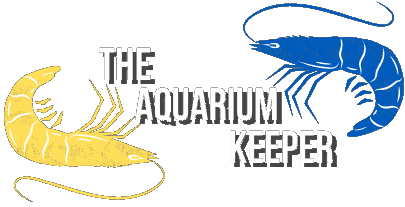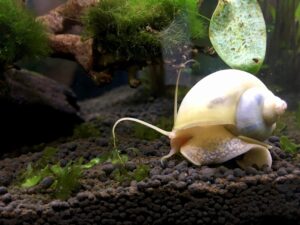
15 Amazing Plants for Your Shrimp Tank

Writer at The Aquarium Keeper
Shrimp is one of the most popular aquarium stocking options because it is fun to watch these little creatures and they do not require a lot of space. Even though shrimp are small and can pretty much live in almost any condition, it does not mean that we, the people responsible for our pets, should not create the best possible environment for our aquarium inhabitants.
Aquarium plants are crucial to shrimp because they provide hiding places, and oxygenate and even clean your aquarium water. Some plants for shrimp tanks are way better options than others, simply because they can provide more shelter and hiding places. This article will break down the 15 best aquarium plants for your shrimp tank with short guides on how to care for the plants.
Bucephalandra
Buces are one of the most popular plants in the aquarium hobby, they are popular due to their dark-green looks, and the ability to tolerate a wide range of different water parameters. Although this plant can be sometimes hard to find in some places and can be pricy, it is an excellent aquarium plant for your shrimp tank.
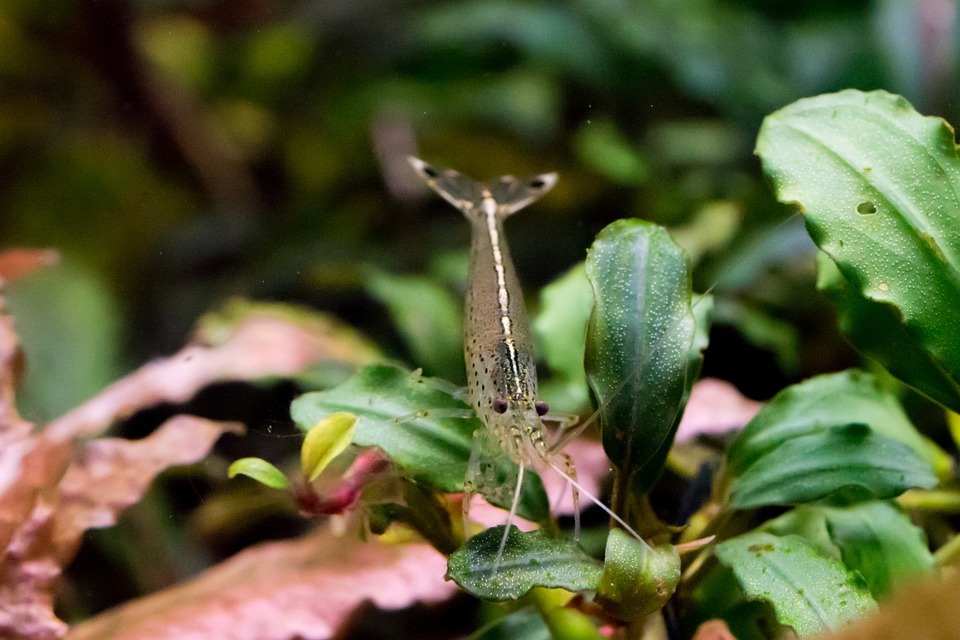
Even though bucephalandra can tolerate a lot of different conditions, it is also important to know the best parameters, so that you could get the most out of this aquatic plant:
- Scientific name: Bucephalandra
- Water temperature: 22–29 °C (72–84 °F)
- Growth rate: Slow
- Lightning intensity: Low to medium
- pH: 5 – 8
- Need for CO2: Low
- Fertilizer: Liquid fertilizer, nutrient-rich substrate
- Planting: On decorations, driftwood, and rocks. Can be planted in the substrate if the rhizome is not buried
- Tank position: foreground / midground
- Maximum height: 7 in / 18 cm
- Care level: Easy
- Minimum tank size: 5 gallons
There are about 30 different bucephalandra species, that have different looks. Some species are darker and have even brown leaves, while other variants even have some red color. Even though bucephalandra is not very dense, this plant is very good for your shrimp tank, because it also provides a lot of hiding places.
Bucephalandra is also one of those aquarium plants, that have the ability to grow partially out of water. This ability to adapt only shows how tough this aquatic plant is. It also does not require a lot, you can easily grow this plant in low-tech shrimp tanks with minimal lightning, although we would recommend using liquid fertilizer for better growth results.
You might also like to read: 5 Best and Worst Tank Mates for Your Cherry Shrimp
Anubias
Anubias is widely used in the aquarium hobby. People like this plant, because it is so flexible, and can pretty much be used in any aquarium setup. Shrimp also love this plant, it provides them with hiding places, and also dying leaves can be an excellent source of food for shrimp.
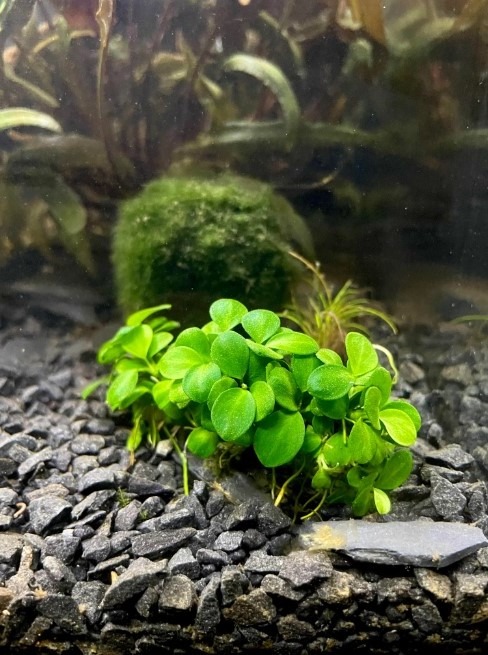
Just like with every aquatic plant, it is important to know in what conditions they do best in. Here is the basic information about anubias:
- Scientific name: Anubias
- Water temperature: 23–28 °C (74–82 °F)
- Growth rate: Slow
- Lightning intensity: Low to medium
- pH: 5.5 – 8
- Need for CO2: Low
- Fertilizer: Liquid fertilizer, nutrient-rich substrate
- Planting: Can be planted on rocks, wood, decorations, and can also be planted in substrate if the rhizome of the plant is not buried
- Tank position: Foreground / midground
- Maximum height: 7.5 in / 19 cm
- Care level: Easy
- Minimum tank size: 5 gallons
Anubias can be an excellent plant for a shrimp tank, because the large leaves of the plant provide a lot of hiding places and shade. It also does not need a lot of lightning, so if this plant is going to be kept in a high-tech shrimp tank, anubias can start developing algae on the leaves. In this situation, shrimp can easily eat the algae of the plant.
There are also countless anubias species to choose from, which have different leaf sizes and coloration. Also, similar to bucephalandra, anubias plants are also amphibious, which means they can easily grow out of the water and can live partially submerged.
Java Fern
The next plant on this list is Java fern. This plant is good for a shrimp tank, because the leaves of this plant grow very densely, which provides a lot of cover for shrimp, especially shrimp babies, which are very vulnerable during their youth.

This is a low-tech beginner plant, that really does not require a lot of resources to successfully grow. Here is some basic information about java fern:
- Scientific name: Microsorum pteropus
- Water temperature: 20–28 °C (68–82 °F)
- Growth rate: Slow
- Lightning intensity: Low to medium
- pH: 6 – 7.5
- Need for CO2: Low
- Fertilizer: Liquid fertilizer, nutrient-rich substrate
- Planting: Can be attached to decorations, wood, rocks, and also planted in the substrate, without burying the rhizome part of the plant
- Tank position: Foreground / midground
- Maximum height: 14 in / 35 cm
- Care level: Easy
- Minimum tank size: 5 gallons
Unlike bucephalandra and anubias, java fern has long and edgy leaves. It does not need a lot of lightning to grow but combined with liquid fertilizer it will surely take off in your shrimp tank. This plant is also good for your shrimp tank, because shrimp can eat the dying leaves of this plant whenever they feel hungry.
Java Moss
Java moss probably is one of the best aquatic plants for a shrimp tank, because it creates a jungle that only shrimp can enter. It is so dense compared to other aquatic plants, that shrimp can easily use this plant as a hiding spot.

This particular plant is different from the other aquatic plants mentioned above. It can’t be planted in the substrate, because it will simply rot. Here is the information about java moss:
- Scientific name: Taxiphyllum barbieri
- Water temperature: 21–25 °C (70–77 °F)
- Growth rate: Slow
- Lightning intensity: Low to medium
- pH: 5.5 – 8
- Need for CO2: Low
- Fertilizer: Liquid fertilizer
- Planting: Can be attached to wood, rocks, driftwood
- Tank position: Foreground / midground
- Maximum height: 9 in / 23 cm
- Care level: Easy
- Minimum tank size: 5 gallons
Java moss can easily grow anywhere in the tank. You can leave it floating around, or choose to attach it to some sort of decoration. Java moss can be attached using string, or glue that is safe for aquariums. Also, java moss can be used as a carpeting plant, which would create a lot of small hiding places for baby and adult shrimp.
Vallisneria
This particular plant is very good for your shrimp tank, because it reproduces quickly, and creates a dense, jungle-type environment in your aquarium. Vallisneria also does not require a lot and can grow easily in minimal conditions.

There are a lot of different vallisneria species, that vary in looks and size, but almost all of them are beginner friendly and easy to grow. Here is some basic information about this plant:
- Scientific name: Vallisneria
- Water temperature: 20–28 °C (68–82 °F)
- Growth rate: Fast
- Lightning intensity: Medium to high
- pH: 6.5 – 8
- Need for CO2: Low
- Fertilizer: Liquid fertilizer, nutrient-rich substrate
- Planting: Plant the base of the plant and the roots into the substrate
- Tank position: Midground / background
- Maximum height: 21 in / 53 cm
- Care level: Easy
- Minimum tank size: 5 gallons
Cryptocoryne
There are a lot of different cryptocoryne species, that have their own unique color and leaf sizes, but all cryptocoryne plants are excellent for shrimp tanks. This plant grows very densely, which creates a lot of little gaps and places where shrimp could hide. Cryptocoryne also creates a lot of shade, in which shrimp could stay and not be seen by other potential aquarium inhabitants.

Before making the decision to have cryptocoryne in your shrimp tank, read the following information about this plant:
- Scientific name: Cryptocoryne Wendtii
- Water temperature: 20–28 °C (68–82 °F)
- Growth rate: Moderate
- Lightning intensity: Low to moderate
- pH: 6 – 7.5
- Need for CO2: Low
- Fertilizer: Liquid fertilizer, nutrient-rich substrate
- Planting: The base of the plant and roots need to be planted in the substrate
- Tank position: Midground
- Maximum height: 20 in / 51 cm
- Care level: Easy
- Minimum tank size: 5 gallons
Salvinia
Salvinia or also known as “water spangles” is a floating plant, that is widely used in all aquarium setups. This plant is very good for a shrimp tank because shrimp like to hang around on salvinia roots, and at the same time this plant is excellent at sucking out excess waste and nutrients out of the water, stabilizing water parameters, and keeping it clean.
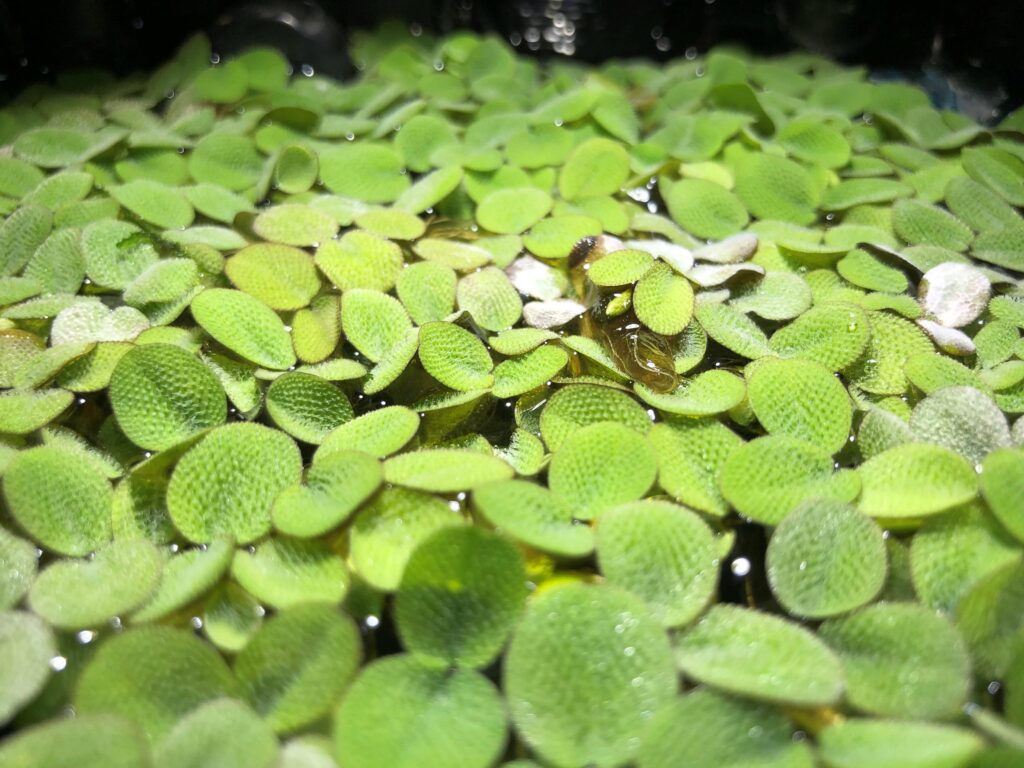
Salvinia is one of those plants, that can almost grow in any freshwater aquarium conditions. Here is the basic information about this aquatic plant:
- Scientific name: Salvinia
- Water temperature: 16–32 °C (61–89 °F)
- Growth rate: Fast
- Lightning intensity: Low to high
- pH: 6 – 8
- Need for CO2: Low
- Fertilizer: Liquid fertilizer
- Planting: Salvinia does not need to be planted, because it is a floating plant
- Tank position: Surface
- Maximum size: 1 in / 3 cm
- Care level: Easy
- Minimum tank size: 5 gallons
Salvinia reproduces on its own, so you do not need to propagate this particular plant. Another reason why salvinia is a good choice for your shrimp tank is that the plant reduces the amount of lighting in your aquarium, which means shrimp have more places to hide.
Hydrocotyle Tripatita
This particular plant species is one of the most flexible plants in the aquarium hobby. Hydrocotyle tripatita can grow planted, attached to decoration, or just left floating. It finds a way to adapt and multiply, which is excellent if you are planning on having a low-tech shrimp tank.

Even though hydrocotyle tripatita is versatile, you should still know the best conditions for this aquatic plant:
- Scientific name: Hydrocotyle tripatita
- Water temperature: 22–28 °C (72–82 °F)
- Growth rate: Fast
- Lightning intensity: Low to moderate
- pH: 5 – 7
- Need for CO2: Low
- Fertilizer: Liquid fertilizer, nutrient-rich substrate
- Planting: Any part of the plant can be planted in the substrate. Also can be attached to decorations, rocks, wood, or just left floating
- Tank position: Midground
- Maximum height: 4 in / 10 cm
- Care level: Easy
- Minimum tank size: 5 gallons
Hydrocotyle tripatita can also be used for carpeting purposes in aquariums. It is very good for a shrimp tank because it grows very dense, and can create a jungle or a vine-type place for shrimp to hide in. Although C02 is not required for this plant, with extra carbon dioxide hydrocotyle tripatita would grow faster and denser.
Hornwort
Similar to hydrocotyle tripatita, hornwort is a very flexible plant, that can grow planted, floating, or attached to some sort of decoration. This plant is good for sucking up bad stuff from aquarium water and reducing lightning in the tank.
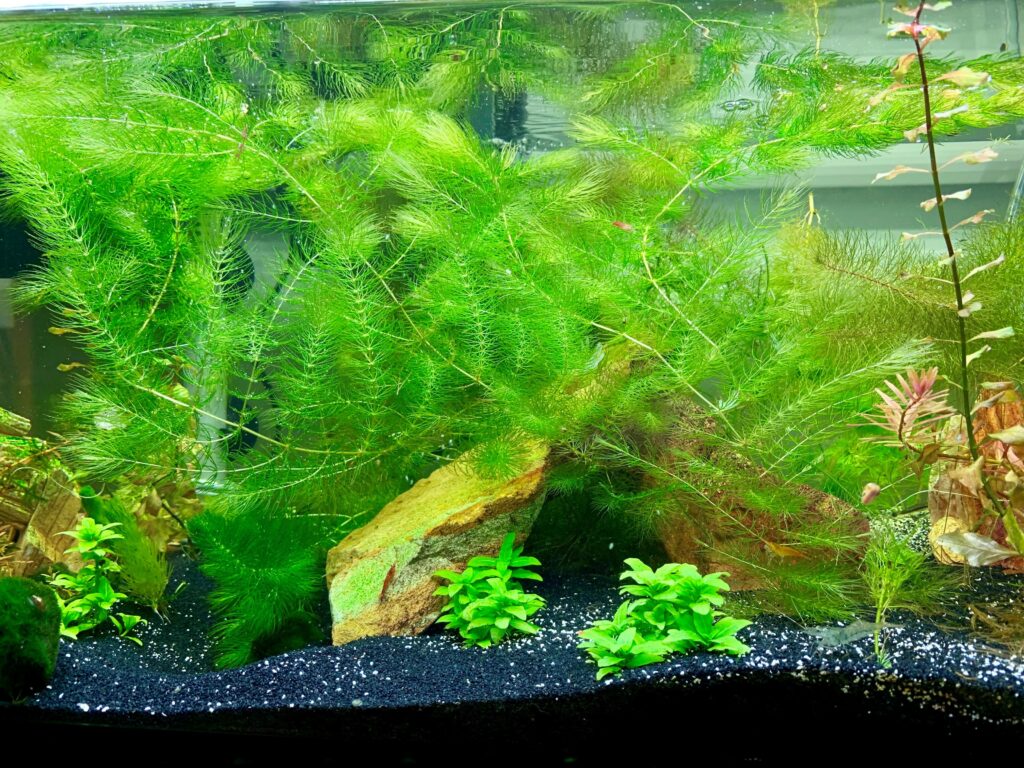
There are countless instances in the hobby, where people just leave hornwort in a plastic box with minimal sunlight, and this plant easily grows in those conditions. Nevertheless, here is the basic information about hornwort:
- Scientific name: Ceratophyllum demersum
- Water temperature: 15–30 °C (59–86 °F)
- Growth rate: Fast
- Lightning intensity: Low to high
- pH: 6 – 7.5
- Need for CO2: Low
- Fertilizer: Liquid fertilizer, nutrient-rich substrate
- Planting: Hornwort can be planted in the substrate. The leaves of the part that is about to be planted need to be removed, because they will rot in the substrate. It is best to use ceramic planting rings for this plant because it can easily be uprooted.
- Tank position: Midground / background
- Maximum height: 118 in / 300 cm
- Care level: Easy
- Minimum tank size: 10 gallons
Hornwort can grow in small aquariums, but it will easily turn smaller tanks into a jungle, that is why we recommend using this plant in slightly larger setups (10 gallons). This plant is very good for shrimp tanks, because of its leaves. Hornwort leaves are similar to pine needles, and are very close together, which creates the perfect environment for shrimp to hang out in and hide if needed.
You might also like to read: Can Cory Catfish and Shrimp Live Together?
Anacharis
To continue, anacharis is another plant, that could create a jungle-type environment for your shrimp. This plant has leaves that are close together, and it would provide excellent hiding spots for shrimp.
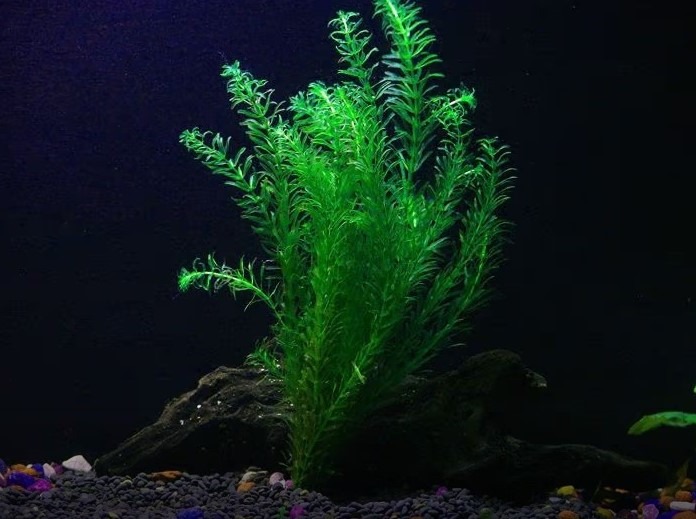
There are more flexible aquarium plants in this list, but anacharis have amazing looks, and if you like this plant, you should know the basic information about it:
- Scientific name: Egeria densa
- Water temperature: 20–25 °C (68–77 °F)
- Growth rate: Fast
- Lightning intensity: Moderate
- pH: 6 – 8
- Need for CO2: Low
- Fertilizer: Liquid fertilizer, nutrient-rich substrate
- Planting: This plant can only grow by being planted in a nutrient-rich substrate
- Tank position: Background
- Maximum height: 118 in / 300 cm
- Care level: Easy
- Minimum tank size: 10 gallons
Amazon Sword
Next on the list is amazon sword. This plant is particularly strong and can tolerate a wide range of water parameters. Also, the big leaves of this plant can provide a lot of shade for shrimp to hide in.
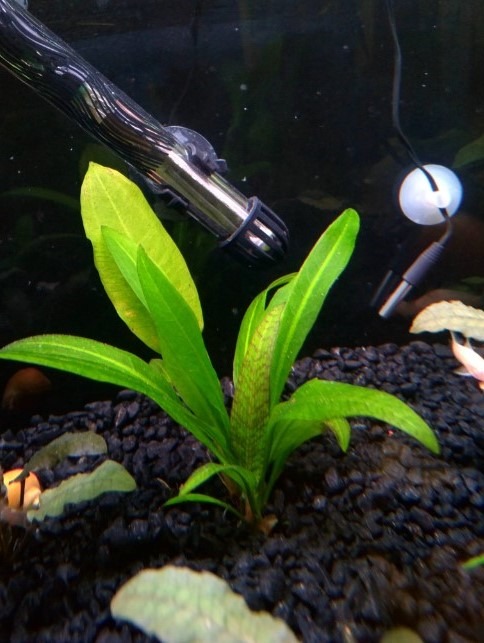
Before making the decision about getting yourself this aquatic plant, be sure you have a bigger tank. Here is more information about amazon sword:
- Scientific name: Echinodorus grisebachii
- Water temperature: 22–28 °C (72–82 °F)
- Growth rate: Slow
- Lightning intensity: Moderate
- pH: 6 – 8
- Need for CO2: Low
- Fertilizer: Liquid fertilizer, nutrient-rich substrate
- Planting: Plant the lower part of the plant and the roots into nutrient-rich substrate
- Tank position: Background
- Maximum height: 18 in / 46 cm
- Care level: Easy
- Minimum tank size: 20 gallons
Water Wisteria
Moving on, water wisteria can also be used in shrimp tanks. The leaves of this plant have unique patterns and can be a good hiding place for shrimp. Similar to anacharis, this plant is propagated by cutting the top piece of the plant and planting it into the substrate. Having a bunch of water wisteria close together can create a dense environment of aquatic plants, that shrimp would love.

Just like all of the plants on this list, water wisteria is hardy, and won’t give you a lot of problems. Here is more information about this plant:
- Scientific name: Hygrophila difformis
- Water temperature: 22–28 °C (72–82 °F)
- Growth rate: Fast
- Lightning intensity: Moderate
- pH: 6.5 – 7.5
- Need for CO2: Low
- Fertilizer: Liquid fertilizer, nutrient-rich substrate
- Planting: Lower part of the plant is planted in the substrate
- Tank position: Background
- Maximum height: 20 in / 51 cm
- Care level: Easy
- Minimum tank size: 10 gallons
You might also like to read: 10 Common Reasons Why Your Aquarium Plants Are Dying
Pearl Weed
Pearl weed or “baby tears” is a good plant for a shrimp tank. This plant can be used as a carpeting plant, or just left floating around the tank. Compared to other plants on this list, pearl weed needs a little more care to grow normally, so it would not be the best plant for low-tech shrimp tanks.

Pearl weed has a bright green look to it and can be an excellent hiding spot for smaller shrimp in your tank. Here is the basic information about pearl weed:
- Scientific name: Hemianthus micranthemoides
- Water temperature: 20–28 °C (68–82 °F)
- Growth rate: Moderate
- Lightning intensity: Moderate to high
- pH: 6.5 – 7.5
- Need for CO2: Moderate
- Fertilizer: Liquid fertilizer, nutrient-rich substrate
- Planting: Can be left floating around, or can be planted a in nutrient-rich substrate
- Tank position: Foreground / midground
- Maximum height: 5 in / 13 cm
- Care level: Moderate
- Minimum tank size: 5 gallons
This plant needs more light and more CO2 to do better. Also, pearl weed can be propagated by clipping the top of the plant and replanting again into the substrate. It is a good plant for shrimp to hide in, especially baby shrimp.
Dwarf Sagittaria
Dwarf sagittaria is very similar to vallisneria, but it is way smaller and does not grow that big. This plant can easily be used as a carpeting plant and can create a dense jungle at the bottom of your tank for your shrimp to be in.

This plant is very easy to take care of, it does not require a lot and can definitely be used in low-tech setups. Here is more information about dwarf saggitaria:
- Scientific name: Sagittaria subulata
- Water temperature: 20–27 °C (68–81 °F)
- Growth rate: Fast
- Lightning intensity: Moderate
- pH: 6 – 8
- Need for CO2: Low
- Fertilizer: Liquid fertilizer, nutrient-rich substrate
- Planting: Lower part of the plant needs to be planted in a nutrient-rich substrate
- Tank position: Foreground / midground
- Maximum height: 5 in / 13 cm
- Care level: Easy
- Minimum tank size: 5 gallons
This plant propagates on its own. Dwarf saggitaria lets out runners, that eventually come out of the substrate as new smaller plants. Combining nutrient-rich substrate and liquid fertilizer, you can easily create a carpet of dwarf saggitaria for your shrimp.
Dwarf Hairgrass
Imagine dwarf hairgrass as your natural grass that you find outside, but only for aquariums. This plant can grow so close together, that not even the smallest predators would not find your shrimp in this plant. Although it is an excellent plant for your shrimp tank, it can be a little bit needier compared to other plants on this list.
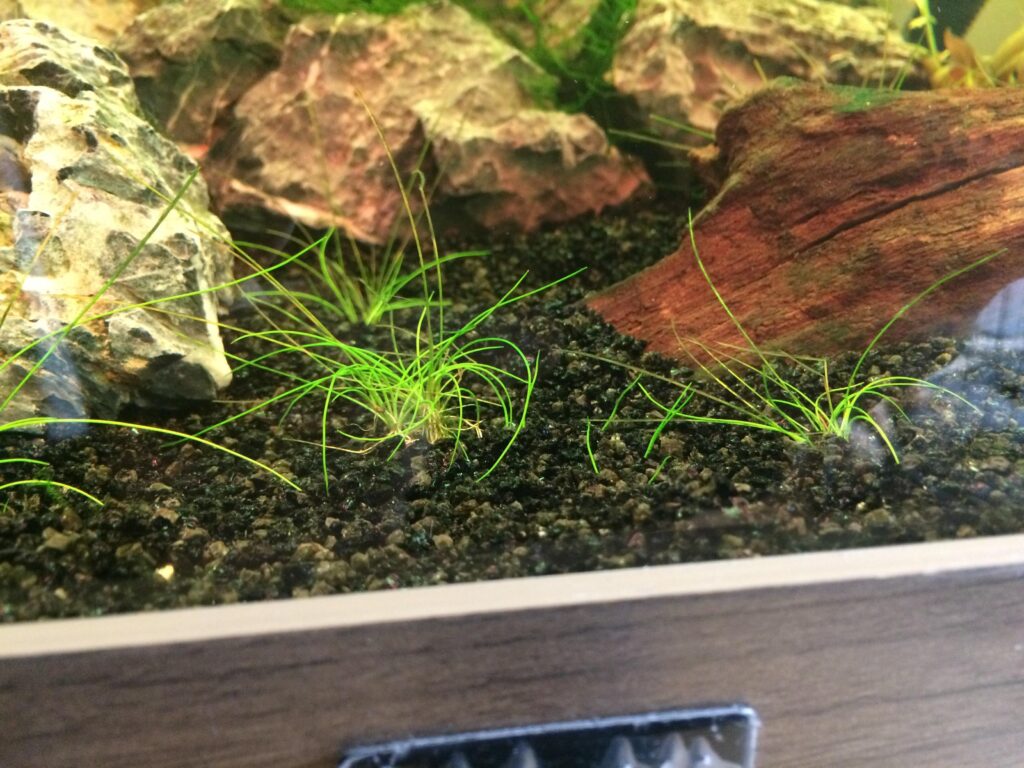
Dwarf hairgrass is mostly used as a carpeting plant. Similar to vallisneria and dwarf saggitaria, this plant also creates runners, that slowly take over the bottom part of your aquarium. Here is the basic information about dwarf hairgrass:
- Scientific name: Eleocharis parvula
- Water temperature: 22–26 °C (72–79 °F)
- Growth rate: Moderate
- Lightning intensity: Moderate to high
- pH: 6 – 8
- Need for CO2: High
- Fertilizer: Liquid fertilizer, nutrient-rich substrate
- Planting: This plant is best planted in chunks around the bottom part of your tank in a nutrient-rich substrate
- Tank position: Foreground
- Maximum height: 6 in / 15 cm
- Care level: Moderate
- Minimum tank size: 5 gallons
Frequently Asked Questions
Can Fake Plants be Used in Shrimp Tank?
Fake plants will do no harm to your shrimp, but it is important to understand, that real plants are the best plants for shrimp. Live plants help clean the aquarium water, and in general, are better to look at. We highly recommend using live plants in your shrimp aquarium.
Do Shrimp Eat Aquarium Plants?
Shrimp might only eat the dying parts of your plant (old leaves). Sometimes it may look like your shrimp is eating an aquarium plant, but in most cases, they just are eating the algae that are on the plant. If your shrimp is well-fed, it would not touch even the dying parts of your aquarium plant.
Writer's Thoughts
I believe that shrimp is one of the best aquatic creatures in the hobby. They live in very simple conditions, but it is important to create an environment, where shrimp would feel safe. The plants mentioned above help create that desired environment. It might mean that you would see your shrimp less due to all the plants, but at least they would be way happier.
If you enjoyed reading our article, please feel free to share it with your friends by clicking the social media buttons below:
